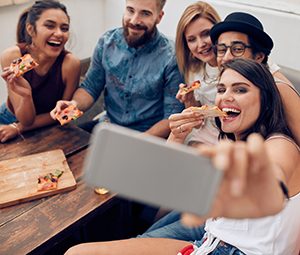 With hackers being able to gain more access to our personal details, it’s about time to make sure we protect the information we put online about ourselves and share with the world. Increasing your social media privacy will undoubtedly make you less vulnerable to hackers. When you access your social media account, look in the security or privacy tabs to change your settings. When in doubt, click through all the various tabs in the preferences pages for your account and adjust security settings.
With hackers being able to gain more access to our personal details, it’s about time to make sure we protect the information we put online about ourselves and share with the world. Increasing your social media privacy will undoubtedly make you less vulnerable to hackers. When you access your social media account, look in the security or privacy tabs to change your settings. When in doubt, click through all the various tabs in the preferences pages for your account and adjust security settings.
Here are the 10 things you should protect yourself from:
- Login Information
- Most social media sites offer two-factor authentication which is highly recommended in preserving the security of your login credentials
- You can enable notifications for new login attempts so you are made aware if and when someone is trying to access your account
- Be sure not to use the same passwords for all of your social media accounts, and ensure they’re strong and contain a combination of upper and lower case letters as well as numbers and symbols. Password Managers are recommended so that you can have secure and diverse passwords all across the board
- Posts and Comments You Make
- There are many aspects of your account that you can make private and it’s important to monitor the permission of who gets to view your posts and comments
- Even though you moderate your audience and limit their reach, you should still post with caution. Even with privacy settings enabled, what you share online could be there forever
- Messages and Comments You Receive
- You can limit who can message you or who can comment on your posts by blocking specific people and groups, or only allowing contact from friends, or friends of friends
- Contact Information
- Usually when you open a social media account, they require you to input certain contact details such as your phone number, email, or maybe even your address. These items could be searchable online unless you state otherwise to protect these details
- Your location might even be known unless you disable that functionality
- Notifications
- You can customize the notifications you receive on social media, by selecting who you want to receive or block notifications from.
- Photo and Video Tags
- You have the right to approve whether someone can tag you in a photo that is linked to your profile. It is not the default option, so it’s important to know you must enable it in order to add this extra layer of security
- Connected Accounts
- Ensure that you’re satisfied with what information you are making accessible to third-parties and that you disconnect from unused applications that you have linked to your social media accounts
- You don’t want third-party applications to have unnecessary access to your personal information and social data.
- Friends
- Be sure to only accept friend requests from people you know. It’s not uncommon for hackers to send you friend requests so they can be privy to see personal information that want hidden from the public
- Your Comments
- Don’t share when you’re going on vacation a plane ticket, or anything online. You don’t want someone to break into your house, or take the information on the QR code from our boarding pass to steal your identity
- Passwords
- Be sure not to use the same passwords for all of your social media accounts, and ensure they’re strong, containing a combination of upper and lower case letters as well as numbers and symbols. Password Managers are recommended so that you can have secure and diverse passwords all across the board.
Social media gives you limitless opportunities to connect with friends and family, but it can also be scary from a security perspective. maximize your privacy and security settings!
 With hackers being able to gain more access to our personal details, it’s about time to make sure we protect the information we put online about ourselves and share with the world. Increasing your social media privacy will undoubtedly make you less vulnerable to hackers. When you access your social media account, look in the security or privacy tabs to change your settings. When in doubt, click through all the various tabs in the preferences pages for your account and adjust security settings.
With hackers being able to gain more access to our personal details, it’s about time to make sure we protect the information we put online about ourselves and share with the world. Increasing your social media privacy will undoubtedly make you less vulnerable to hackers. When you access your social media account, look in the security or privacy tabs to change your settings. When in doubt, click through all the various tabs in the preferences pages for your account and adjust security settings.